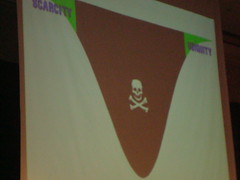Day two at SES Chicago opened with a keynote speech from Seth Godin talking about Meatball Sundaes.
So what’s this Meatball Sundae all about?
Let’s break it down first: The meatballs are the core of the organization whether it’s products, services or traditional marketing.
The sundae, the whipped topping, nuts, sprinkles and cherry is what new marketing provides including channels like social media.
I’m sure we can all agree that a meatball sundae does not sound appetizing, but they’re being created across organizations with marketers trying to force traditional messages into new online channels.
Seth encouraged the audience to embrace what the web wants and architect your messages accordingly.
Specifically, Seth gave the audience 14 Trends that can help us avoid making a meatball sundae:
1. Direct Communication with your target market.
Stop creating go-betweens and hurdles that stop your customers from talking to YOU.
2. Consumers are louder than ever before.
If consumers are Chatty Cathy’s, give them something of value to talk about and make it easy for them to pass along.
3. Authentic stories.
Building off number 3, give your consumers a story. They no longer have the time/nor do they want to listen to everything your company has to say, but capitalize on the fact that everyone likes to be told a story and they love to retell interesting, funny or engaging ones.
4. Speed.
If a competitor can offer the same product/service faster than you, you’ve got a problem. Figure out a way to be the first to respond to a consumer getting price quotes from various companies.
5. Don’t ignore the Long Tail.
Half of all books sold on Amazon, are those that Barnes & Noble doesn’t even carry. Why give consumers 3 choices when you can offer 30. Adapt and customize to meet customers’ needs.
6.Outsourcing.
Don’t kill great ideas because of cost. Develop great ideas and then figure out a way to reduce costs by outsourcing. For example, you can call Jott.com leave yourself a message and a reminder will be in your Inbox within a few hours. How? The company outsources to India for translating the voice recording to email.
7. The dicing of everything
The web, especially Google, loves to unbundle things. Articles, products, etc. Be prepared to be unbundled.
8. Infinite Channels of Communication
Whether it’s TV, Radio or Online consumers have an infinite number of channels from which to glean information. They are in fact overwhelmed with messages, so don’t try harder to reach them. Someone is not going to decide to start clicking on banner ads one day unless it speaks directly to them and offers something relevant of great value.
For example, I don’t remember ever having clicked on a banner ad. However, there was one the other day offering 15% of Bears apparel at NFLShop.com. This is extremely relevant to me as everything on my husband’s Xmas list is Bears-related. So why wouldn’t I click and make the same purchase and save 15%!
If you can’t create a relevant message and get it in front of the right audience, then consider architecting something new and different.
9. Scarcity & Abundance
There has been a flip in recent years. What used to be scarce (ways to spend free time) is now abundant. What used to be abundant (free water) is now scarce.
10. Triumphant of Big Ideas
Big ideas don’t have to be extraordinarily produced; they just have to be shared. Let the story be the main focus, not how the story is told. YouTube Videos are an excellent example.
11. Who vs How Many
Stop paying attention to how many and start paying attention to WHO. The Whos are worth far more than 50 million of the wrong people that ignore you and will never respond.
12. The New Rich
The rich are different than 30 or 40 years ago. Figure out the rich people are in your marketplace and what they want.
13. New Gatekeepers & No Gatekeepers
We’ve all heard about gatekeepers, TV stations, Newspapers and even people like Rupert Murdoch and Oprah. Now we have online channels where there are no gatekeepers. Anyone can post anything online and if it’s good, it will spread.
14. Scarcity & Ubiquity
This is what Seth presented as an upside down bell curve.
Scarcity is the idea that people are willing to fly to Las Vegas to see Jerry Seinfeld, because the opportunity is rare and the memory outweighs the cost.
On the other side is Ubiquity where folks get the information for free and then use that information to make decisions about what is scarce. i.e. reruns of Seinfeld are free, but seeing him in person is not.
Seth believes that consumers are no longer interested in the middle information, which is the reason for the skull.




